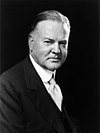Agricultural Marketing Act of 1929
- Introduced in the House as H.R. 1 by Gilbert N. Haugen (R–IA) on April 17, 1929
- Passed the House on April 25, 1929 (365-35)
- Passed the Senate on May 14, 1929 (54-33)
- Reported by the joint conference committee on June 13, 1929; agreed to by the House on June 13, 1929 (250-113) and by the Senate on June 14, 1929 (74-8)
- Signed into law by President Herbert Hoover on June 15, 1929

The Agricultural Marketing Act of 1929, under the administration of Herbert Hoover, established the Federal Farm Board from the Federal Farm Loan Board established by the Federal Farm Loan Act of 1916 with a revolving fund of half a billion dollars.[1] The original act was sponsored by Hoover in an attempt to stop the downward spiral of crop prices by seeking to buy, sell and store agricultural surpluses or by generously lending money to farm organizations. Money was lent out to the farmers in order to buy seed and food for the livestock, which was especially important since there had previously been a drought in the Democratic South. However, Hoover refused to lend to the farmers themselves, as he thought that it would be unconstitutional to do so and if they were lent money, they would become dependent on government money.
Effects
The Federal Farm Board's purchase of surplus could not keep up with the production; as farmers realized that they could just sell the government their crops, they reimplemented the use of fertilizers and other techniques to increase production. Overall, the deflation could not be countered because of a massive fault in the bill: there was no production limit. Had there been a production limit, the deflation might have been helped somewhat. The funds appropriated were eventually exhausted and the losses of the farmers kept rising.
The H.R. 1 legislation was passed by the 71st Congressional session and enacted by the 31st President of the United States Herbert Hoover on June 15, 1929.[2]
The Act was the precursor to the Agricultural Adjustment Act.
References
- ^ Chapter 4: Crisis and Activism: 1929-1940, United States Government Printing Office
- ^ Gerhard Peters; John T. Woolley. "Herbert Hoover: "Statement on the Enactment of the Farm Relief Bill and on Plans for the Federal Farm Board.," June 15, 1929". The American Presidency Project. University of California - Santa Barbara. Archived from the original on 2016-03-04.
External links
- Peters, Gerhard; Woolley, John T. "Herbert Hoover: "Letter to the Speaker of the House Recommending Appropriations for the Federal Farm Board.," June 17, 1929". The American Presidency Project. University of California - Santa Barbara.
- Peters, Gerhard; Woolley, John T. "Herbert Hoover: "Executive Order 5200, Transferring the Division of Cooperative Marketing to the Federal Farm Board.," October 1, 1929". The American Presidency Project. University of California - Santa Barbara.
- v
- t
- e
- 31st President of the United States (1929–1933)
- 3rd United States Secretary of Commerce (1921–1928)
(timeline)
- Transition
- Inauguration
- Foreign policy
- Hoover Dam
- Agricultural Marketing Act of 1929
- Reapportionment Act of 1929
- Wall Street Crash of 1929
- Smoot–Hawley Tariff Act
- National anthem
- Economy Act of 1932
- Revenue Act of 1932
- Mexican Repatriation
- Federal Home Loan Bank Act
- Hooverville
- Banana Wars
- London Naval Treaty
- Hoover Moratorium
- Stimson Doctrine
- Cabinet
- State of the Union Address, 1929
- 1930
- Presidential transition of Franklin D. Roosevelt
- Judicial appointments
- Executive Orders
- Hoover desk


- Bibliography
- Presidential Library, Museum, and gravesite
- Hoover Institution Library and Archives
- Hoover Tower
- Hoover Institution
- Herbert C. Hoover Building
- U.S. Postage stamp
- Hoover Medal
- Hoover Chair
- Hoover Field
- Backstairs at the White House (1979 miniseries)
- The Angel of Pennsylvania Avenue (1996 film)
- Freedom Betrayed
- English translation of De re metallica
- Lou Henry Hoover (wife)
- Herbert Hoover Jr. (son)
- Allan Hoover (son)
- Margaret Hoover (great-granddaughter)
 Category
Category
 | This United States federal legislation article is a stub. You can help Wikipedia by expanding it. |
- v
- t
- e











